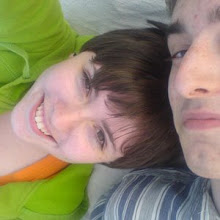This is the final resolution that was made for the book of 100 brief. I wanted a box that looked like a book, as you can see. I bound it like a book, and to be honest, I'm really pleased with how the box turned out. My first attempt at making a box didn't work at all, and I managed to superglue my work to the table, but it was soon rectified. My flatmate told me that I should just make these boxes and sell them. I think she wants one.
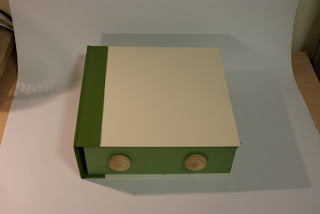
The wooden wheels on the side, which are actually wagon wheels for doll house vehicles or whatever, are the turning mechanism for the 'scroll' type book inside. I had to make the holes of the wheels a little wider by scraping the inside of a pair of scissors. Easier than I imagined it would be.
Anyway, I thought that the wood looked good against the green and cream coloured box, and seemed to fit in with the whole feel of 'green'. Green as in eco-friendly. Despite using wood not really being the most eco friendly thing to use. Aesthetically it works, however.
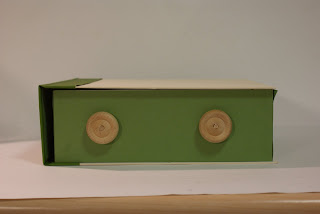
This is the inside of the box, and as you can see, this is the first version of the 'scroll' book I made. It was very long, my illustration took up about..25 A4 pages altogether, I believe. During a crit, the one on the day before the deadline in fact, A lot of people felt that it was far too long, and they didn't get what the cars had anything to do with anything. They got bored with turning it about halfway though, so I bought some Pro Plus and got cracking as soon as I got home. It was a
long night.
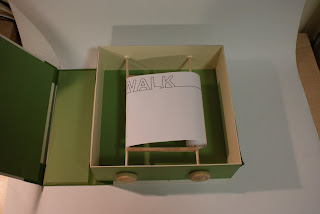
And this is the second attempt at the scroll mechanism within the box. I changed it quite a lot, and made it
much shorter. I didn't take anything out, I just shrank everything down so it covered about eight pages instead. Another thing I did, was I removed the car illustrations and put them in a seperate line, which I coloured red, which indicates several things. First, it imitates the red light which is keeping all the cars stationary and stuck in a traffic jam, and second, red is a colour that connotes the bad things in life.
Which is why the figure dancing around is coloured green, because the green is good and better for the environment, as well as the signal for go. This time, only the figures are on scrolls, because while they move from side to side, the car illustration can't physically move anymore, meaning it's stuck while the person has the freedom of movement. That was what I intended, at least.


This is the cover of the book. My original intention was to have the 'Green Person' aka, the walk signal, sprayed onto the front cover, but I chose against it. I used this question instead, because posing a question to the viewer automatically asks their opinion and makes them curious as to how to answer it. That is my way of getting people to look at this book. I was going to spray paint this onto the front cover, but I ran out of time and had to stick a piece of acetate on instead.
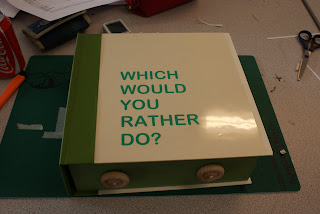
This is my workstation on the day of the deadline, hah. Caffeine, Sausage roll...what a way to start the day.
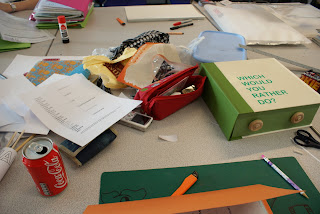
The turning mechanism was not as smooth as I would have hoped for, but I feel that it was the best that I could managed with my limited tools and limited experience with making such things. That, and actually spray painting the cover of the book, are the main things that I would change about this design had I had a little more time, but overall, I'm pleased with the result.
-HJ x

 The above two images were made using paint brushes in Illustrator. I really like how messy and scrappy they turned out, but they are still completely readable, unlike some of the results that I came out with.
The above two images were made using paint brushes in Illustrator. I really like how messy and scrappy they turned out, but they are still completely readable, unlike some of the results that I came out with. This image below was clearly made using the dotted lines and scissor marks that we see on an image that needs cutting out. Because there were so many lines and corners in the actual type, it went a little crazy, but I think it looks good. It's still readable, thought interesting to look at.
This image below was clearly made using the dotted lines and scissor marks that we see on an image that needs cutting out. Because there were so many lines and corners in the actual type, it went a little crazy, but I think it looks good. It's still readable, thought interesting to look at.
 The image below is my favourite. I accidently created it using one of those page divider deals on Illustrator, and it went crazy but I really like how it looks. I'm going to play around a lot more with type in future now that I realise just how I can make type far more interesting.
The image below is my favourite. I accidently created it using one of those page divider deals on Illustrator, and it went crazy but I really like how it looks. I'm going to play around a lot more with type in future now that I realise just how I can make type far more interesting.



















































